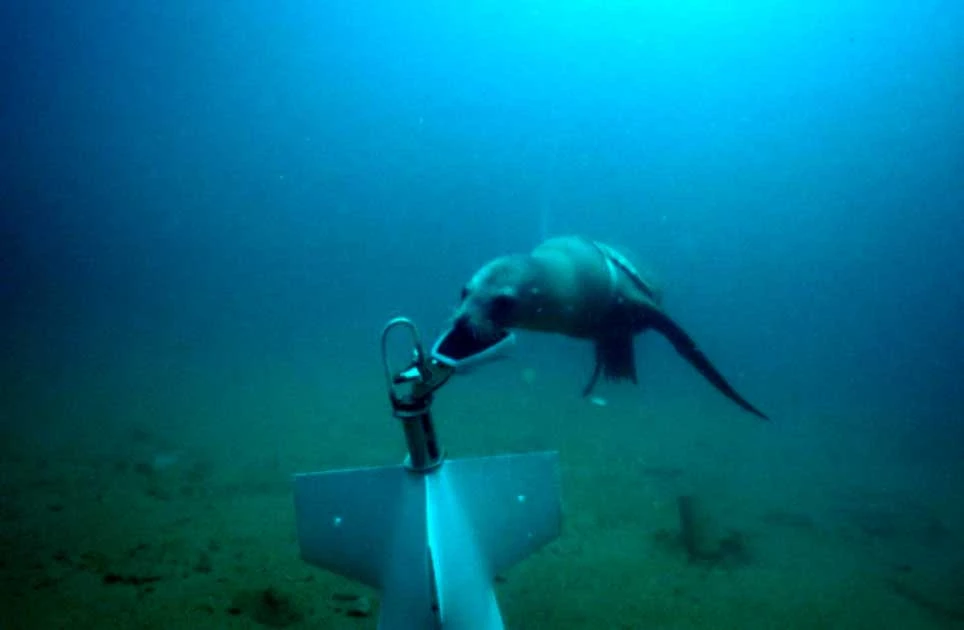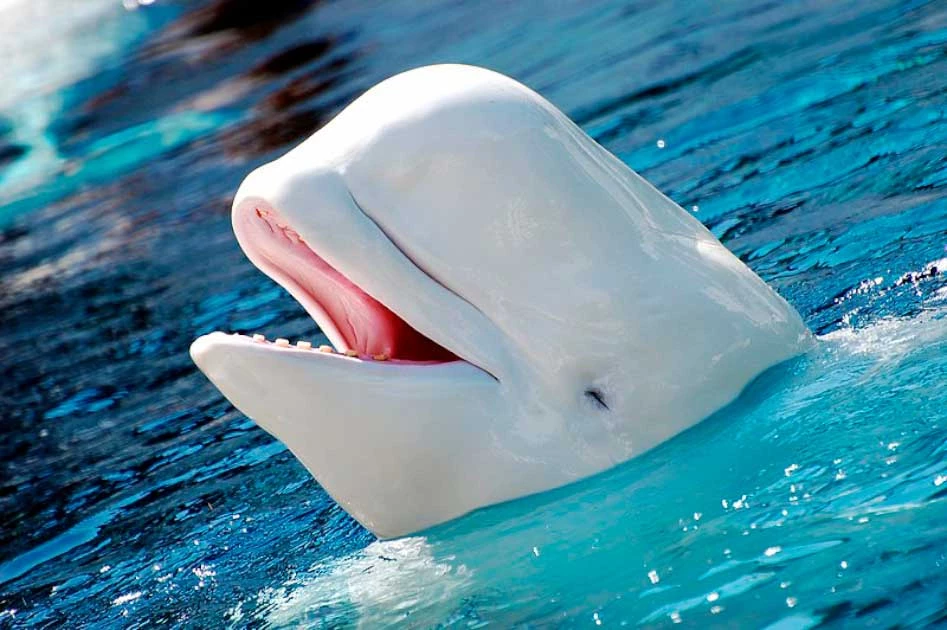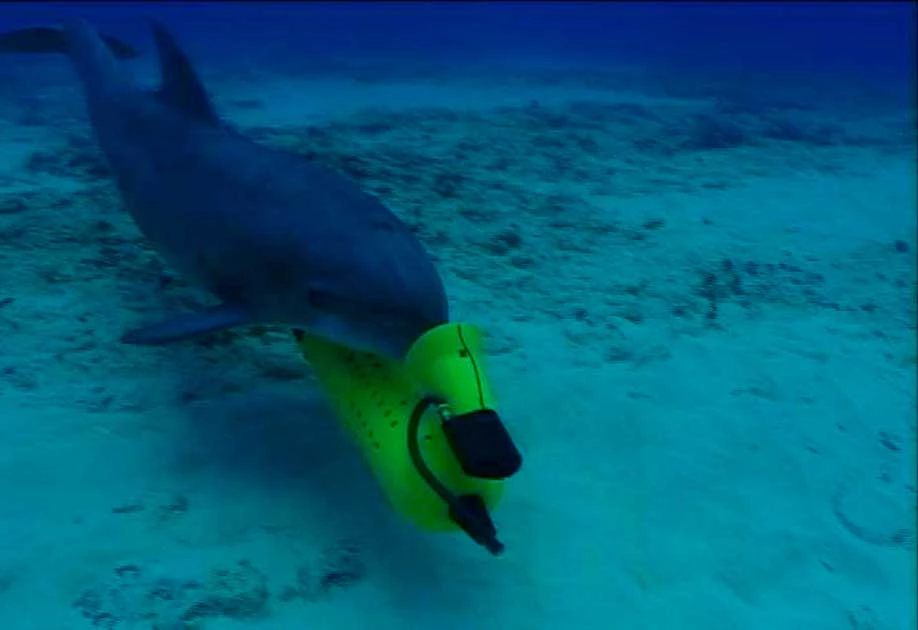In 2005, the British newspaper, The Observer, published an article claiming around 36 US military dolphins secretly being trained near Lake Pontchartrain in the United States were washed away due to Hurricane Katrina, and were on the loose. What made the news even more scandalous was that an investigator claimed the dolphins were fitted with special harnesses that allowed them to fire deadly darts at anyone in the water they identified as spies.
At first glance this news story in the wake of a natural disaster sounds more like the film Austin Powers, International Man of Mystery. In the movie, the character Dr. Evil demands his henchmen give him “Sharks with frickin laser beams attached to their heads” but has to settle for ill-tempered bass.
While the alleged killer dolphins were not real and dolphins cannot fire any weapon, some of the details in the story were real. The US military does have trained Military Marine Mammals who serve in the US Navy.
These military mammals have existed and have been used since the Cold War, and while secret spy dolphins sound like a lot of fun, the animals serve a much more tame role in the Navy. Think about it, why would the Navy not want to have Military Marine Mammals who can do things humans and specialized equipment will never be able to do? What are these animals trained to do?
Military Marine Mammals
The US Navy created the Navy Marine Mammal Program (NMMP) in the 1960s with two primary goals. The first goal was to study the underwater sonar capabilities of both dolphins and beluga whales to learn how to design better methods for detecting objects underwater.

The second goal was to research how dolphins can swim fast and have the ability to dive deep. This information was going to be used to increase the speed and depth capabilities of Navy ships and submarines.
It was during the Cold War that Military Marine Mammals research was at its peak. The Soviet Union was also doing similar research with dolphins to “dominate the underwater front”. If they couldn’t control outer space, they would be okay with controlling the open ocean.
In the United States, these projects were highly classified, and it wasn’t until 1992 that the Military Marine Mammals projects and research became declassified. What the Navy had trained these Military Marine Mammals to do was incredibly impressive.
Military Marine Mammals from the United States were used during the Vietnam War, the Persian Gulf War, Cold War, and the War in Iraq. Russia has been seen on satellite images transporting Military Marine Mammal pens several times.
When the Soviet Union collapsed in 1991, the Russian Military Marine Mammal unit was given to the Ukrainian military, but they were hardly used. Russian Military Marine Mammal programs expanded and became operational during Russia’s annexation of Crimea in 2014.
The unit somehow was back, apparently a priority and under the control of the Russian Navy. In 1997, many of the Soviet Navy dolphins now are therapy animals for children with autism or other emotional disturbances.
- The Philadelphia Experiment – What’s the Real Story?
- A Mighty Bang: Are We In Danger From Exploding Whales?
Most recently, the Russian Navy was seen placing two dolphin pens along the entrance to the Sevastopol harbor around the same time as Russia invaded Ukraine. Sevastopol is the Black Sea’s largest and most significant Russian naval base.
It is assumed that the tanks were placed in Sevastopol to prevent “Ukrainian special operations forces from infiltrating the harbor in an effort to sabotage warships underwater”. The Russian Northern Fleet near the Arctic has placed pens at the secretive naval base in Olenya, Guba.

Military Marine Mammals have been trained to deliver tools and equipment to divers underwater, guard boats and submarines, locate and retrieve lost items, detect and mark underwater mines, and perform surveillance by holding a camera in their mouths. The US Navy’s Marine Mammal Project is now significantly different from its origins.
A History of Wetwork
In 1960, the Navy acquired a pacific white-sided dolphin to study and research into hydrodynamics and improve torpedo accuracy and performance. However, back then, the technology needed to be more advanced to use the study’s results for anything.
In 1962, the Military Marine Mammal program began a new study. Researchers were amazed at how intelligent dolphins were, how easy it was to train dolphins and the animal’s deep diving skills. A new training facility was created in Point Mugu, California.
At Point Mugu, the intention was to closely study dolphins’ advanced senses, natural sonar, and physiology to see if dolphins and sea lions could perform specific tasks like locating and marking objects found in the ocean. This research illustrated that the trained dolphins would work rather than swim away when they were let into the open ocean (this is likely because the dolphins were trained using food-based incentives and knew if they came back, they would get food as a reward).
A Military Marine Mammal, a dolphin named Tuffy, carried tools and messages from the surface to a deep water habitat 200ft (60m) below the surface in 1965. That wasn’t all Tuffy could do. This Military Marine Mammal was trained to locate lost divers and guide them to safety.
Today, there are five “teams’ ‘ of Military Marine Mammals and humans used by the Navy. The teams are named MK4, MK5, MK6, MK7, and MK8, and each team has different functions. Three of the teams train Military Marine Mammals to detect and mark the location of sea mines tethered to the ocean floor.
MK7 animals have been trained to detect and mark the location of mines on the seafloor or hidden under sediment. If the Military Marine Mammals detect an object, they will drop a buoy; this allows ships and subs to avoid the area and indicates where navy divers should go to neutralize the threat.
Team MK5 was trained to recover equipment fired from ships or dropped from planes into the water. This team only uses sea lions because the sea lions can outperform human divers at this task. Human divers are only able to work for specific amounts of time and often require multiple dives to recover the equipment.

The sea lions find and return the equipment faster than humans every time. The most popular Military Marine Mammals are bottlenose dolphins and California sea lions. Dolphins have an incredibly powerful biological sonar that can do things artificial sonars can’t.
While sea lions lack the sonar skills of dolphins, their hearing underwater is exceptional, and they see very well in low-light conditions. Both dolphins and sea lions are able to perform deep dives, which humans are unable to do.
“Attack Missions”
It has been rumored for years that the Navy trains its Military Marine Mammals to attack enemies in the ocean. This is, to date, simply a rumor. The Navy has officially stated that “because dolphins cannot discern the difference between enemy and friendly vessels, divers, and swimmers, it would be a poor form of warfare”.
- The Megalodon: Could a Giant Shark be Hiding in our Oceans?
- A Sea Cow and a Sea Ape? The Strange Discoveries of Georg Steller
Reports of escaped killer armed dolphins appear in the news every now and then, but the US Navy reports that none of their Military Marine Mammals have escaped or are armed. Tracking and locating mines and retrieving/delivering equipment to divers is the only thing the Military Marine Mammals do. That means there are no exploding dolphins, and they do not use weapons against enemies.
The US Navy has specialized rules and regulations to follow for the care and welfare of their Military Marine Mammals. However, people opposed to the use of these animals feel as though these policies are not enough.
Animal rights activists say that the stress caused by the Military Marine Mammal training is different from their natural lifestyle and that when not working, the animals are kept confined. Other marine mammals have been found to become incredibly stressed when confined to the point they injure themselves, trying to break through their pens and become depressed.
Another significant issue people have with Military Marine Mammals is that they wear “anti-foraging” devices (muzzles) to prevent and stop dolphins from foraging for food while working. Dolphins naturally forage for food, and preventing them from doing their natural behaviors is stressful.
The US Navy claims the muzzles are only used to prevent the dolphins from ingesting any harmful objects. Those opposed to Military Marine Mammals suggest that the muzzles are only used to “reinforce handlers’ control over the dolphins and encourage this control by using food-based incentives”.

One of the other issues animal rights activists speak out against is the transportation of Military Marine Mammals in tanks or dry transfers, which are seen as stressful. It is brought up that dolphins located in areas where Military Marine Mammals are dropped are at risk of harm.
Dolphins are incredibly territorial and are known to attack intruders. One of the most significant concerns about using Military Marine Mammals is that they are at risk every time they work. They worry the animals will set off a mine and die.
In regards to the safety of the Military Marine Mammals while they are working, the Navy has said that the risk of activating a mine is minimal. The animals are trained to drop a marker at the location of the mines; they are not trained to pick the mines up.
Several kinds of mines have been designed not to detonate when an animal comes into contact with the device. Placing a mine into the ocean means animal interaction with the device is high, from fish running into the mine to crabs crawling over the mines buried beneath the sand of the ocean floor.
The final issue those opposed to Military Marine Mammals has is that an enemy who knows mine-seeking dolphins swimming around will shoot and kill the dolphins. This is perhaps the main problem when animals are used for warfare.
Top Image: A California Sea Lion trained to hunt down marine mines as part of the US Military Marine Mammal program. Source: U.S. Fifth Fleet / CC BY 2.0.